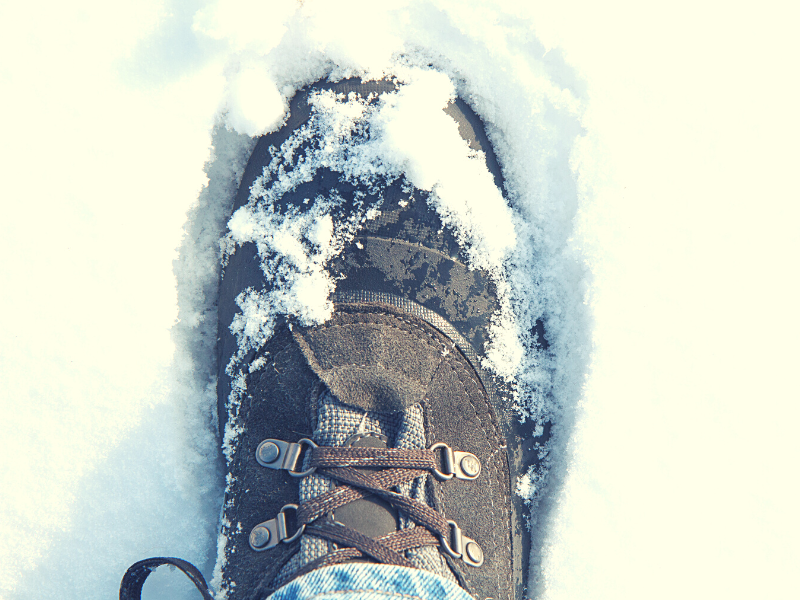Maybe you're the outdoors person who doesn’t let a little bit of cold weather ruin your trekking plans, but you aren’t exactly sure how versatile your hiking boots are in the snow. You don’t want to risk losing traction when ascending tall hills, after all. So, are hiking boots suitable for the snow?
If you’re only walking around in light snow (i.e., a few inches and not blizzard conditions), then hiking boots should be able to insulate and provide enough traction to handle the snow. However, in hard, packed snow as well as in heavier snow, snowshoes, or snow boots are far better choices.
In this guide, we’ll explore how useful hiking boots can be in snowy and icy conditions, and discuss when you’re better off switching to another pair of footwear. By the time you’re done reading, you’ll know just the right footwear choice for any weather you face!
6 Ways To Tell Your Hiking Boots Will Work In Snow
We've all been there - for whatever reason, wearing your hiking boots in the snow is either easier or more logical than throwing on a pair of snow boots, yet not always advised.
In some instances, if your hiking boots meet the following 6 criteria, then yes, you can wear them in the snow.
1. Tall Height
Ask any hiker and they’ll tell you that nothing feels worse than getting water in your boots. Well, perhaps except for getting water in your boots in the frigid wintertime.
The water dries ice-cold around your ankles and under your feet, making each step you take that much more miserable. If your hiking boots cut off below your ankle, then you’re going to experience a lot of the abovementioned sensations of icy water seeping into your boots.
The boots simply lack the height and support to safeguard your ankles and feet from the rush of water.
Your boots need to go well over your ankle for your feet and lower legs to stay dry during your hike.
Hiking boots are available at taller heights, but whether the boots are tall enough for water seepage prevention depends.
2. Insulation
Covering your feet and ankles in hiking boots alone does not insulate them. Rather, it’s through the protection of the boots themselves as well as internal materials that provide the insulation you need.
Microfiber liners insulate from the inside of the boot out. These materials can hold onto the heat that your feet produce so that even if you're shuffling through the snow for hours, your toes don’t end up frozen solid, and numb.
Hiking boots may not necessarily be insulated, especially if yours are a lighter pair of boots designed for hiking in the warmer months of the spring and summer.
Winter hiking boots as well as snow boots are sure to be insulated since these shoes are built for the cold.
3. Waterproofing
If your hiking boots lack waterproofing, you'll find that out rather quickly if you take them for a trek through the snow - your boots, socks, and feet will get drenched.
Traipsing around in wet boots all day is a fast way to put a damper on your hiking trip. After all, your boots won’t have an opportunity to dry until you get out of the cold.
When hiking in the snow, you need boots that contain a waterproof membrane within.
The waterproof liner will wick away the moisture that naturally accumulates in your socks and shoes on your hike. Should you walk through melting or slushy snow, the boots will block moisture so the water doesn’t seep inside.
Snow boots will be rated for higher waterproofing nearly every time though. The boots will be treated with a water-resistant coating that resists exterior moisture so your boots don’t end up slippery and soaked during a winter hike.
Even if your standard hiking boots lack any type of exterior waterproofing, you can always treat them after the fact. However, that won't replace a potential lack of interior waterproof membrane.
4. Traction
In the winter, any hike can turn into an exciting but dangerous adventure, and hiking on a good day already carries with it serious risks.
From ice and snow-packed trails to steep terrain with little slip-resistant cover; hiking is not for those who don't have proper footwear!
One of our most important tools in this category are traction devices which hold on slippery surfaces so you're able to go further than expected before having too much trouble...or falling because you couldn’t stop your fall fast enough due to slipping.
5. Breathability
If your hiking boots are waterproof, then you can rely on them to be breathable as well. Your feet sweat when hiking in any climate, even the snow.
So you need breathable footwear that gives sweat and moisture a place to exit. Otherwise, your feet will become wet heat traps.
The sweaty conditions inside your boots, in conjunction with the slippery conditions outside, also make it much harder to stay steady on your feet as you hike.
6. Comfort
The last consideration is a very important one: comfort. A pair of hiking boots can feel comfortable when you try them on in the store for two minutes, but until you spend considerable time in the boots, you’ll never truly know how comfortable or uncomfortable they can be.
That's why it's so important to break them in before you go on any serious excursion. Comfort is certainly one of a few important reasons to break hiking boots in.
Hiking in the winter isn't exactly the most comfortable activity, as enjoyable as it is to most. You don’t want to further reduce your comfort by wearing boots that are too heavy or don’t fit properly.
What Boots Should You Wear in the Snow?
At the end of the day, you’ll have the easiest and warmest experience when hiking in the snow if you invest in a pair of snow boots.
Snow boots have many of the traits that we listed in the section prior. They’re also outfitted with features that make them a steadfast answer for wintertime hiking.
Here is an overview of those features:
Rubber Bottom
The rubber undersides of snow boots allow for quick drying. Further, water won't saturate the single piece of rubber that comprises each boot bottom, adding a further degree of waterproofing to snow boots.
Tall Height
Snow boots are guaranteed to extend beyond the wearer’s ankle but might go even further still for crossing through deep expanses of snow.
Snow Gaiters
Some snow boots include built-in snow gaiters that go right against your leg.
The gaiter will usually have a fuzzy layer of insulation to further make it difficult for snow to slip down your leg and into your boot. If not a built-in gaiter, then you’ll see a pull-up gaiter in snow boots.
This gaiter style features a drawstring or elastic for adjusting how close the waterproof gaiter sits against either side of your leg.
Are Hiking Boots Snowshoes?
Snowshoes are a specialized type of footwear with an overly big footprint that distributes your weight with each step. When wearing snowshoes, you’re not walking through the snow but rather, atop it. This keeps your feet drier for easier, longer-term treks.
Hiking boots are reliable, strong, and dependable - they're a lot of things, but they are not a replacement for snowshoes.
Now, you can attach snowshoe bindings to a regular pair of shoes to make them snowshoe-ready. If you own a good pair of winter hiking boots, then they’re a suitable candidate.
On their own though, hiking boots are not snowshoes.
What about ice or other cold weather conditions, do the same rules apply?
Are Hiking Boots Good for Ice?
If you want to avoid slipping and sliding on ice, make sure your boots are as sturdy as possible. You can lose traction with even the slightest misstep - falling could be disastrous! So that must mean hiking boots aren't great for ice, right? Yes and no.
Your hiking boots might give you a good grip when hiking on dirt paths or climbing rocky expanses, but on ice, it’s a whole different ballgame. But, you're hiking boots can be good on ice if you outfit them with traction grips.
What Are Traction Grips?
Traction grips are devices that you attach to the bottom of your shoes or boots to give them extra traction on icy surfaces. They usually take the form of metal or thermoplastic rubber spikes and studs that dig into the ice, providing a more secure grip.
The cleats connected to the traction grips lock into the ice with each step you take, preventing your feet from slipping or wobbling on uncertain terrain.
Some traction grips even include stainless steel chains, sort of akin to tire chains, that lend you even more traction. Not only are traction grips usable on ice but in slippery snow as well.
Hiking Boots Can Work in Some Snow Conditions
Hiking boots can be a solution for crossing snow (and even ice) under some circumstances.
That said, if you’re looking for an alternative to snow boots this winter, your hiking boots may work, with the right attributes. At a minimum, they should be insulated, waterproof, breathable, and hit above the ankle.
If they don’t, then you’re better off switching to snow boots, as this footwear is wholly designed for keeping snow out.



